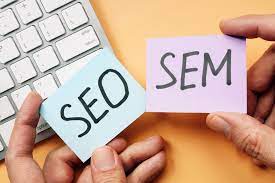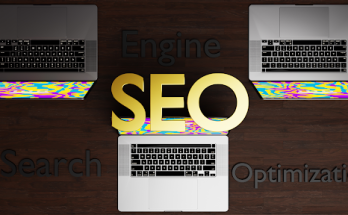What’s the Difference Between SEO and SEM?
Search engine marketing is a vital mechanism to enhance a brand’s web visibility and boost traffic. If you want to improve your website’s performance on search engine results, you need in-depth knowledge of both SEO and SEM. These two concepts are two sides of the same coin, but they work toward the same outcome. Indeed, companies that leverage both PPC ads and search engine optimization (SEO) enjoy 27% more profits and 25% more clicks.
However, digital marketers must know when to use SEO and SEM to achieve profitability and encourage brand growth. These techniques may be what your business requires to catapult to the next level when used correctly.
What Is SEO
SEO describes the tactics that businesses use to rank highly on organic search engine results. Essentially, search engine results are either organic or paid. SEO intends to increase organic traffic to your site.
Google processes 3.8 million global searches every minute on average, and it uses web crawlers to give people the best possible result for their search. The Google algorithm utilizes over 200 factors to rank websites, including the total number of backlinks, organic click-through-rate (ctr), high-quality content, and keyword placements.
The core SEO techniques are:
- On-Page SEO
On-page SEO is where you optimize the elements of one web page to rank higher in search engine results pages (SERPS). Such elements include title tags, meta descriptions, image alt tags, keywords, and headings. Keyword research is a popular SEO technique where digital marketers strategically discover and use specific keywords to rank better for related search terms.
- Off-Page SEO
Typically, websites with high authority backlinks rank better in organic search results. Hence, focus on link-building strategies like getting high-quality backlinks from reputable websites, public relations, and content marketing.
- Technical SEO
Technical SEO relates to optimizing a website’s technical components, like page load time, URL structure, site speed, mobile-friendliness, and security.
What Is SEM?
Search engine marketing is when marketers use paid search tactics to achieve better visibility in SERPs and drive traffic to their sites. Usually, marketers buy pay-per-click ads from Google AdWords, Bing, Yahoo, Microsoft, or any other search engine to have the brand appear high on search engine results. In addition to PPC ads, companies leverage other SEM strategies to boost visibility on paid search results such as local SEO, display marketing, and product advertising.
How SEM Works
Bidding is critical in paid ads, where website owners and marketers bid on a specific keyword. In practice, the ad from the highest bidder shows up at the top when someone makes a Google search for the keyword. You pay your bidding amount when someone clicks on your ad, known as the cost per click (CPC).
Your quality score represents your ad’s relevancy to search queries. Essentially, Google determines the quality score based on the quality of your landing pages, click-through rate, and the overall quality of your Google ad account. Also, optimize your ad assets such as images and copy to deliver tailored ads that boost your click-through rate.
SEO vs. SEM: Similarities
SEO and SEM are complementary elements of search marketing. Specifically, both strategies increase brand visibility as they help your business rank higher in SERPs. People searching for queries on search engines find it via organic or paid results. As such, you can use both SEO and SEM to rank better in the long term.
Additionally, SEO and SEM increase website traffic by getting more people to click on a particular search result. The two techniques are also concerned with the quality of traffic, and marketers have to understand their audiences to use SEO and SEM effectively. Through keyword research, marketers can reach their target audience and improve their site’s conversion rate.
Differences
The main difference between SEM and SEO is that the former relies on paid advertising while the latter earns search visibility. SEM works as long as you pay, while SEO is a long-term marketing strategy to drive and analyze organic traffic. Other key differences between the two are:
- SEM Search Results Have Ad Extensions, While SEO Results Feature Snippets
PPC campaigns and organic SEO search results appear differently on search result pages. Usually, ad placements have an ad icon and can include phone numbers and additional links. In contrast, search engines don’t mark SEO search results. But, rich search results that appear at the top of SERPs just below paid ads usually contain featured snippets.
- SEO Takes Longer to Give Results, But It Offers a Higher ROI Than PPC Campaigns
An SEM campaign results in immediate results, but the results have no long-term value. In comparison, an SEO strategy costs more to implement as more people are involved, and it costs a lot of money to curate good content and build links.
However, a good SEO marketing strategy can keep your web pages at the top of search engine results for years, earning your site authority in the long term. What’s more, you can repurpose the best-forming web pages into other forms of content, such as infographics, social media posts, digital signage content, podcasts, or video series.
- SEM Tactics Are Easier to Learn, While SEO Has a Steeper Learning Curve
SEO has many rules, and search engines constantly modify how they rank websites. You have to master how search engines operate and keep up with algorithm changes, which for Google occur about 500-600 times yearly. In contrast, you can launch PPC campaigns as soon as you get familiar with a PPC platform.
- SEO Results Outperform SEM Ads on Click-Through Rates
If you want high click-through rates with SEO, you have to be one of the first few organic search results for particular keywords. Ranking high for organic results is especially crucial because 75% of users don’t explore beyond the first page of search results.
- SEM Allows Faster Testing Than SEO
SEM is the ideal digital marketing tool for quick testing and insight gathering. Marketers can test ad copy, bidding strategy, and keywords for an SEM marketing campaign as soon as it is active. On the other hand, you can take months to determine if your SEO tactics are working.
In Conclusion
Now that you comprehend the difference between SEO and SEM, you will find it easier to incorporate them into your marketing strategies. Ultimately, SEO is ideal for already-established brands with relatively optimized sites for organic search. SEM is a good tactic for new
businesses with a minimal online presence with websites that need a lot of work to improve SEO. Also, SEM is best for brands that don’t know their target market very well and would instead test a few ideas first.



